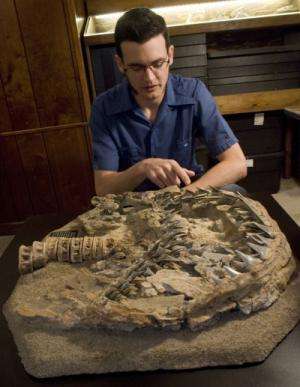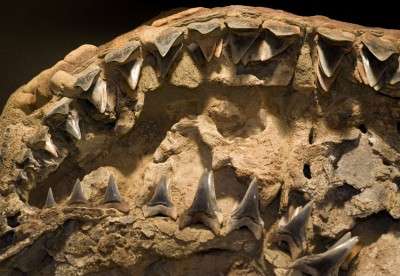New ancient shark species gives insight into origin of great white

(Phys.org)—The great white shark is one of the largest living predatory animals and a magnet for media sensationalism, yet its evolutionary history is as misunderstood as its role as a menace.
Originally classified as a direct relative of megatooth sharks, the white shark's evolutionary history has been debated by paleontologists for the last 150 years. In a study appearing in print and online today in the journal Palaeontology, University of Florida researchers name and describe an ancient intermediate form of the white shark, Carcharodon hubbelli, which shows the modern white shark likely descended from broad-toothed mako sharks. The study deviates from the white shark's original classification as a relative of megatooth sharks such as the extinct Carcharocles megalodon, the largest carnivorous shark that ever lived.
Based on recalibrated dates of the excavation site in Peru, the study also concludes the new species was about 2 million years older than previously believed.
"We can look at white sharks today a little bit differently ecologically if we know that they come from a mako shark ancestor," said lead author Dana Ehret, a lecturer at Monmouth University in New Jersey who conducted research for the study as a UF graduate student. "That 2-million-year pushback is pretty significant because in the evolutionary history of white sharks, that puts this species in a more appropriate time category to be ancestral or kind of an intermediate form of white shark."
Most ancient shark species are named using isolated teeth, but analysis of C. hubbelli, also known as Hubbell's white shark, was based on a complete set of jaws with 222 teeth intact and 45 vertebrae. The species was named for Gainesville resident Gordon Hubbell, a collector who recovered the fossils from a farmer who discovered them in the Pisco Formation of southern Peru in 1988. Hubbell donated the specimens to the Florida Museum of Natural History on the UF campus in December 2009.

"The impetus of this project was really the fact that Gordon Hubbell donated a majority of his fossil shark collection to the Florida Museum," Ehret said. "Naming the shark in his honor is a small tip of the hat to all the great things he has done to advance paleontology."
Ehret and co-authors published an initial study describing the shark specimens in the Journal of Vertebrate Paleontology in 2009, but dates for the site reflected information from a 1985 study about the Pisco Formation, he said. With Hubbell's hand-drawn maps and descriptions of the landscape, researchers returned to the site and found the exact spot the fossils were discovered.
Scientists extracted more accurate age estimates from mollusk shells in the fossil horizon to determine the shark species was from the late Miocene, about 6.5 million years ago, rather than the early Pliocene, about 4.5 million years ago. The new dates will also be useful for better understanding other fossils found in the rich Pisco Formation, which include new whale, marine sloth and terrestrial vertebrate species.
"The thing that was remarkable to me was that these fossils came from right out in the desert and this was before GPS, so Dana had only an approximate notion of where it was," said Florida Museum of Natural History Director Douglas Jones, a study co-author who conducted strontium isotope dating of the fossils. "But after a few days of looking, we were able to find this deposit and Dana found the rest of the missing shark's teeth."
Researchers determined Hubbell's white shark was related to ancient broad-toothed mako sharks by comparing the physical shapes of shark teeth to one another. While modern white sharks have serrations on their teeth for consuming marine mammals, mako sharks do not have serrations because they primarily feed on fish. Hubbell's white shark has coarse serrations indicative of a transition from broad-toothed mako sharks to modern white sharks.
These evolutionary relationships have been hypothesized for decades, and researchers who interpret modern white sharks as being more closely related to megatooth sharks say it is "a friendly disagreement," according to Michael Gottfried, an associate professor in geological sciences at Michigan State University.
But shark expert David Ward, a research associate at the Natural History Museum, London, said "fewer people believe the big megatooth sharks are related to the great white sharks than believe the Earth is flat."
"Everyone working within the field will be absolutely delighted to see this relationship formalized," Ward said.
Journal information: Palaeontology
Provided by University of Florida




















